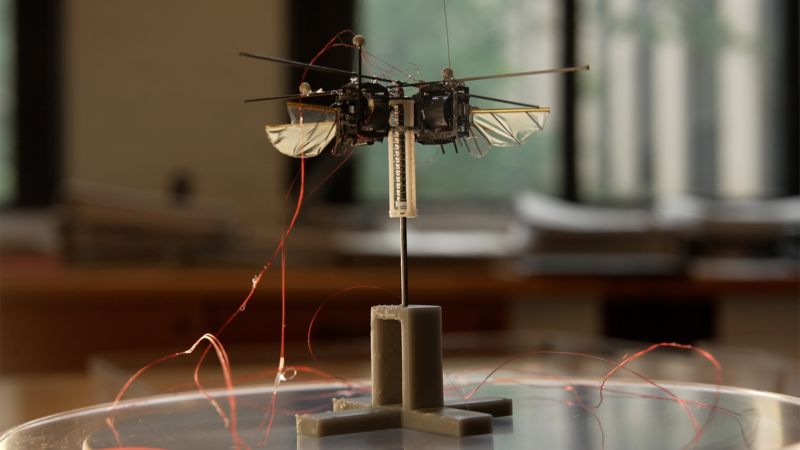A bee-like robot currently under development at the Massachusetts Institute of Technology (MIT) is part of a new generation of bots inspired by creepy crawlies.
The machine, which weighs less than a paperclip, can flap its wings up to 400 times a second and has achieved a maximum speed of two meters (6.5 feet) per second. It can also flip and hover.
“We’re just trying to mimic these amazing maneuvers that bumblebees can achieve,” says Yi-Hsuan “Nemo” Hsiao, a fourth-year PhD student who is working on the robots.
Researchers hope that it could someday help with tasks like artificial pollination, maybe even on other planets.
“If you’re going to grow something on Mars, you probably don’t want to bring a lot of natural insects to do the pollination,” says Hsiao. “That’s where our robot could potentially come into play,” he adds.
Kevin Chen, an associate professor at MIT and the principal investigator at its Soft and Micro Robotics Lab adds that the team doesn’t want to replace bees, but put the robots to work in scenarios where the insects can’t.
They could be used in warehouse farms with rows of crops stacked high and ultraviolet lighting, he says: “It’s very difficult for bees to survive in that environment.”
Across the world, technologists are taking lessons from nature to create robots that might perform better at complex tasks or in difficult environments than traditional technology.
At Yale University, researchers developed a gecko-inspired robot that can amputate its own limbs – a capability that could be helpful in search and rescue missions in dangerous rubble, according to its creators.
And researchers at South Korea’s Chung-Ang University recently unveiled a soft robot that can bend and crawl like a caterpillar.
“Millions of years of evolution has helped to give (insects and animals) the best solution, especially for any type of locomotion,” says Hsiao, who writes the algorithms that tells the bee robots how to move.
The robot bee flies using soft artificial muscles that elongate and contract to flap the wing, developed by PhD candidate Suhan Kim. The robot’s laser-cut wings, and its tiny internal mechanisms, similar in size to watch components, are also made in-house.
The team is also working on a grasshopper-like robot. The machine, smaller than a human thumb, can hop 20 centimeters (almost 8 inches) into the air and take on terrains ranging from grass to ice to a leaf. Hsiao says that the jumping robot is more energy efficient than a flying robot.
The small size of the bee and grasshopper-like robots means they could be useful for search and rescue missions or exploring places like the inside of a pipeline or a turbine engine.
Hsiao says the next step in taking the technology into the real world is to add sensors that can feed information to the robots, and batteries to power them. The machines currently rely on a wire to power them. “It’s very difficult to put a small energy source onboard tiny robots,” adds Chen.
The ability to deploy a fully autonomous robot in the field could be 20 to 30 years away, he estimates.
But studying insects’ natural abilities will give his team a jumpstart. “They have evolved for millions of years” says Chen. “There’s a lot to be learned from insect motion, behavior and structure.”
